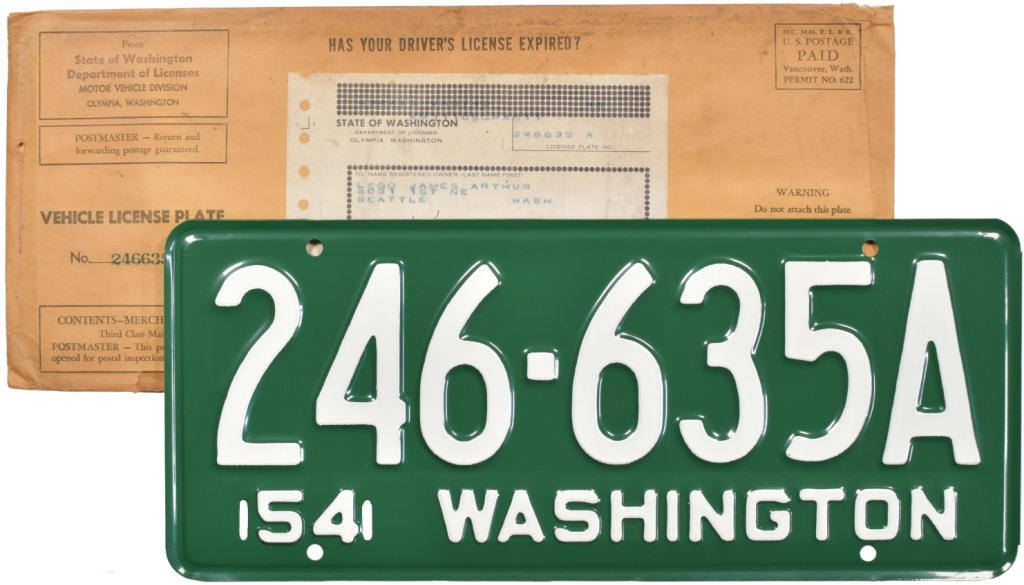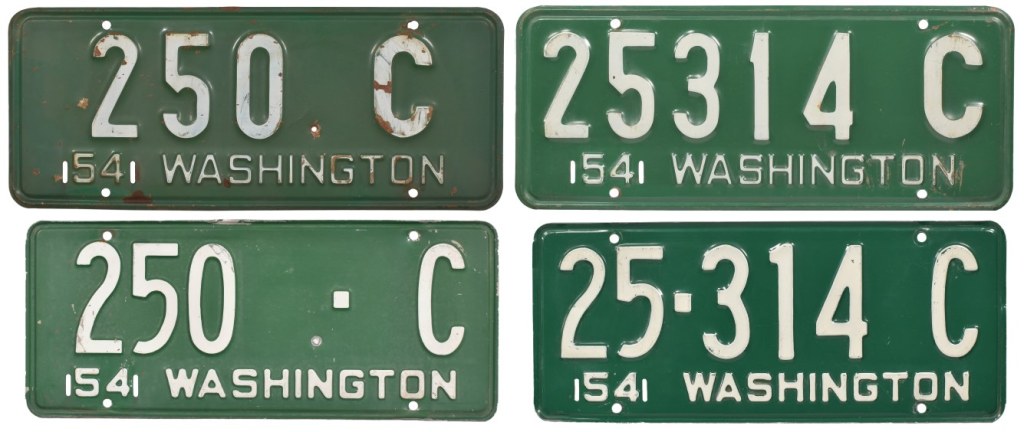Three years later, in a scathing report, state examiners would call it an “ill-advised,” “chaotic situation” lacking a “well-thought-out program,” which cost taxpayers almost $3 million in today’s dollars.
The issue? The Washington Department of Licensing’s reversal, in the fall of 1954, of its decision to issue 1954 license plates as singles instead of pairs. The late change required manufacturing a duplicate of every license plate and shipping each one to the correct owner, a task that proved far more difficult and expensive than imagined.
“The chaotic situation which resulted from the method used in the attempt to supply each registered vehicle with a companion plate indicates a lack of a well-thought-out program to accomplish the desired results.”
State examiners’ report, as quoted in the Tacoma News-Tribune, November 7, 1957
The result was a significant cost to taxpayers, a massive administrative burden, public confusion, and notable manufacturing variations in the license plates of the era.

Original Plan: Single 1954 license plates
Until the metal shortages of World War II, Washington had always issued license plates in pairs. The 1947 issue had reverted back to standard practice, but the Korean War had again required singles for late-issue 1951 license plates.

The white-on-green license plates for 1954 replaced everything then on the roads, which dated back as far as the last statewide reissue in 1950. They were manufactured with slots on either side of the “54” date to accommodate metal renewal tabs in future years, through 1957. And, fatefully, they were issued as singles, not pairs.
Different rationales were given for the decision to issue only a rear plate for the 1954 issue. Cost savings was the official justification from the Department of Licensing throughout the ensuing blowback from police, newspapers, and ultimately the state examiners, but newspaper editorials labelled this as inconsistent with their original understanding that the decision was driven by ongoing metal shortages.
Demand for Front Plates
Whatever the reasoning for singles, law enforcement was particularly unhappy with the lack of front license plates, a fact made very public a few months into 1954.
On March 12, three armed men robbed the Seattle-First National Bank at 404 N 85th Street in Seattle’s Greenwood neighborhood. Shooting broke out during the police response, killing Patrolman Frank W. Hardy and wounding two other police officers. The robbers escaped.
Police publicly blamed the lack of front license plates for the difficulty in apprehending the perpetrators.
“When you’re looking for a car loaded with stickup men, you’re a sitting duck if you have to wait until the car goes by until you get a look at the license,” Seattle Police Chief H.J. Lawrence told the Seattle Times on March 15. He additionally stated that he “would ask the Washington State Association of Police Chiefs to go on the record favoring a return to requiring license plates on the front as well as the rear.”
The death of a police officer and the danger to the community brought the front license plate issue to the top of the public’s mind.
After the Greenwood bank robbery, Seattle police complained that the single-license-plate system in vogue this year in Washington state was a handicap in search for the criminals. Demand was made for a return to the fore-and-aft license plates of former years. This inspired the state director of licenses to explain that return to the two-license-plate system is a matter of money, which is not now available in state funds. If memory serves aright, that same official not so long ago was explaining the changeover to one license plate as being necessitated by aluminum shortages; she should at least stick to one story. What’s more, those enforcement officers who now bemoan the lack of front-end license plates should have been more far-sighted; it wasn’t too difficult to see how police would be handicapped by removal of one identification tag. But not a peep was heard from such sources when the change was announced. Public thinking always has favored two license plates; now if enforcement folk will speak up, even though belatedly, and if the license director will make up her mind whether it’s metal or money she lacks, perhaps the citizenry can do something about it.
Seattle Times editorial, March 19, 1954
Front Plates Return
It took almost six months, but eventually the state acquiesced, with the Department of Licensing announcing in early September 1954 that the manufacturing of the front license plates was underway, with shipments to vehicle owners commencing within a few weeks.
The expense was significant: a total of 1.3 million license plates were ordered, at a cost of $0.16 each, and an additional four cents to mail each one, for a total outlay of $260,000 (approximately $3 million in today’s dollars). Manufacturing and distribution began with the smallest batches: Wahkiakum County, having the smallest vehicle population, was first to receive its new plates, with the next-smallest counties following, ending with the largest counties (Spokane, Pierce, and King).
By November 29, press releases stated that front plates had been mailed out in half of the state’s counties, with the rest expected by the end of the year. Any owner who had not received their plate by January 5 was advised to contact the DOL.
As an aside, officials also asked that anyone who received a plate in error or for a vehicle no longer owned return it to the DOL. A regrettably large number of cases would fall into this category.
Mismatched pairs
An inconsequential, but interesting, result of the massive second production batch of the 1954 issue was the wide variation of formats within each pair.
For residents of Pierce, Spokane, and Columbia counties, the existing license plates on the backs of their vehicles were larger steel plates made at the Walla Walla Penitentiary before the fire. Their new front plates, however, were made by the Screw Machine Company, in aluminum, like the rest of the state’s plates.

For everyone else in the state, while their new front plates matched the rears in size and materials, the spacing and hyphenation of the registration numbers on their new plates were typically quite different from what was already on their back bumpers. The Screw Machine Company was wildly inconsistent with its stamping layouts during its tenure as Washington’s license plate provider, which is particularly apparent in these pairs manufactured almost a year apart.

Wasted Front Plates
More than nine months had passed since the original 1954 license plates were first registered. In that time, people moved out of state, bought and sold cars, wrecked their vehicles, or otherwise ended up in a situation where their original registration was moot.
Officials in charge of producing and distributing a second batch of plates, however, had no way to tell which numbers were no longer active. All of them had to be reproduced and mailed to the last known address.
“Some 80,000 ‘second’ license plates have been returned to the state by the people who no longer own the cars for which extra plates were intended [and the state] expects another 20,000 plates to come back,” said the Seattle Post-Intelligencer on February 5, 1955.
Ten months later, the P-I reported that about 33,500 plates could “never be delivered because the cars to which they were assigned have either left the state or have been junked or otherwise taken off the state highways, according to checks of records on the undelivered plates” (October 11, 1955).
An estimated 6,500 other plates potentially had homes but could not be located. To solve the issue, the P-I further reported that law enforcement had been tasked with stopping all Washington cars lacking a front plate and providing the driver with a card to fill out and send to the Department of Licensing.
After completing a review of the entire program in late 1957, state examiners were unsparing in their criticism of the wasted costs and effort. “As a result of these changes, thousands of plates were returned with notations on the shipping envelope such as ‘car wrecked,’ ‘moved,’ ‘this car has been sold’, ‘wrong address,’ ‘no forwarding address’ and quite often ‘wrong license number.’ […] An effort was made to remail these returned plates, in some cases three and four times. Four cents postage was required each time it was returned as return postage was guaranteed.”
Ultimately, the state had to scrap thousands of license plates that never found homes.
Historical Artifacts

One positive outcome for collectors decades later is the mint, unused 1954 license plates that occasionally turn up in their original mailing envelopes. While not exactly common, these survived at a relatively high rate, either from people who never bothered to comply with the law and attach their front plates, or from mis-shipped plates that nobody took the effort to return to officials.
And so, a series of seemingly minor administrative decisions created a lasting legacy of mismatched license plate pairs and perfectly preserved unused plates.